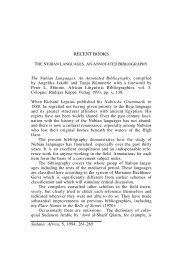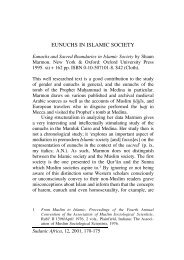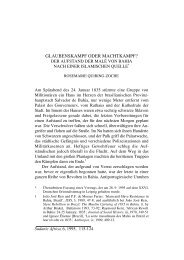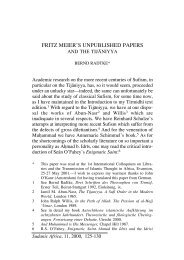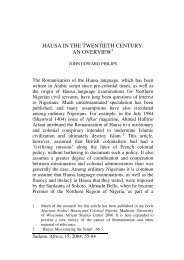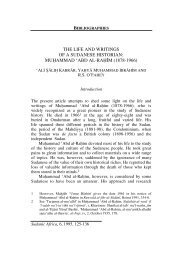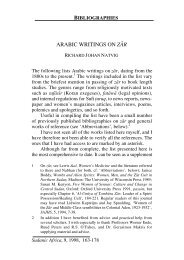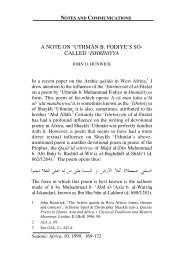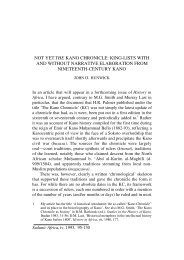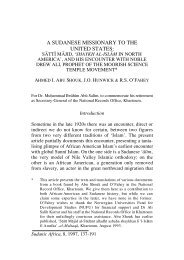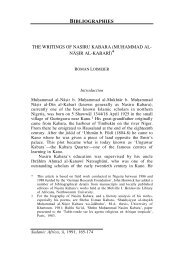Muslim Women's Quest for Equality: Between Islamic Law and ...
Muslim Women's Quest for Equality: Between Islamic Law and ...
Muslim Women's Quest for Equality: Between Islamic Law and ...
You also want an ePaper? Increase the reach of your titles
YUMPU automatically turns print PDFs into web optimized ePapers that Google loves.
638 Ziba Mir-Hosseini / <strong>Between</strong> <strong>Islamic</strong> <strong>Law</strong> <strong>and</strong> FeminismReturn to the Sharia, from which the Islamists draw their legitimacy <strong>and</strong>power when they are in opposition, may become their Achilles heel nowthat they are in power.Another legacy of the <strong>Islamic</strong> revolution in Iran has been the emergenceof an indigenous <strong>Islamic</strong> feminism. Like the re<strong>for</strong>mists, the feminists ofIranhave been theoretically inspired by the New Religious Thinking, while theirwritings have been in<strong>for</strong>med by both their experiences under the <strong>Islamic</strong>Republic <strong>and</strong> the specific politics of gender in Iran. 14 But their quest <strong>for</strong>equality <strong>and</strong> their discourse are parts of a new gender politics among <strong>Muslim</strong>sworldwide, to which I now turn.The Emergence of <strong>Islamic</strong> Feminism<strong>Muslim</strong> women, like other women in the world, have always been awareof—<strong>and</strong> resisted—gender inequality; yet the emergence of a sustained, indigenousfeminism was delayed until recently. This delay at least partly reflectsthe complex relation between women’s dem<strong>and</strong>s <strong>for</strong> equal rights <strong>and</strong>the anticolonial, nationalist movement of the first part of the twentiethcentury.At a time when feminism, both as a consciousness <strong>and</strong> as a movement,was being shaped <strong>and</strong> making an impact in Europe <strong>and</strong> North America, italso “functioned to morally justify the attacks on native (<strong>Muslim</strong>) societies<strong>and</strong> to support the notion of the comprehensive superiority of Europe,” asLeila Ahmed among others has shown. 15Nineteenth-century European travellers <strong>and</strong> diplomats regularly reportedon what they considered the subjection of women in <strong>Muslim</strong> societies.The rise of anticolonialist <strong>and</strong> nationalist movements put <strong>Muslim</strong>s onthe defensive with regard to traditional gender relations. The situation wasfurther complicated by the rise of modern nation-states in the <strong>Muslim</strong>world <strong>and</strong> their appropriation of Islam <strong>and</strong> the “woman question” in theprocess of nation building. New regimes not only selectively re<strong>for</strong>med theclassical rules of <strong>Islamic</strong> family law, grafting them onto a unified legal system;they also tried to define the scope of women’s rights <strong>and</strong> to controlnascent women’s activism. The degree to which they succeeded or failed inthis varied from country to country <strong>and</strong> from one period to another. 1614. See, <strong>for</strong> instance, Azadeh Kian, “Women <strong>and</strong> Politics in Post-Revolutionary Iran: TheGender-Conscious Drive to Change,” Women Living under <strong>Muslim</strong> <strong>Law</strong>s 21 (July 1998): 32–55; Mir-Hosseini, “Stretching the Limits: A Feminist Reading of the Shari‘a in Post-Khomeini Iran,” inIslam <strong>and</strong> Feminism: Legal <strong>and</strong> Literary Perspectives, ed. Mai Yamani (London, 1996), pp. 285–319;Afsaneh Najmabadi, “Feminism in an <strong>Islamic</strong> Republic: ‘Years of Hardship, Years of Growth,’” inIslam, Gender, <strong>and</strong> Social Change, ed. Yvonne Haddad <strong>and</strong> John Esposito (Ox<strong>for</strong>d, 1998), pp. 59–89; <strong>and</strong> Parvin Paidar, “Feminism <strong>and</strong> Islam in Iran,” in Gendering the Middle East: EmergingPerspectives, ed. Deniz K<strong>and</strong>iyoti (London, 1996), pp. 51–68.15. Leila Ahmed, Women <strong>and</strong> Gender in Islam: Historical Roots of a Modern Debate (NewHaven, Conn., 1992), p. 154.16. See Mounira Charrad, States <strong>and</strong> Women’s Rights: The Making of Postcolonial Tunisia,Algeria, <strong>and</strong> Morocco (Berkeley, 2001); Women, Islam, <strong>and</strong> the State, ed. K<strong>and</strong>iyoti (Basingstoke,



